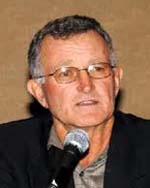The Power Serve:
Part 1
Page 2 By Bruce Elliott
Three Forms of Trunk Rotation
So you want to use the trunk to develop power in the serve.
Your trunk can rotate in three different ways, so let's examine each one. It can rotate forward, like I'm going to do a somersault. That's forward rotation. It can rotate as if there was an axis stuck through my head. So I can twist around this long axis. Or, I can have my back shoulder rotate over the top of my front shoulder.
Let me go through that again. I can rotate forward. I can twist backwards, then forwards. And I can have the back shoulder rotate over the top of the front shoulder, as in a cartwheel.
In the past, I probably believed that you just rotated around a twist axis, and that's the key to the service.
I twist back. I twist forward. Seems logical. That seems to be what all the coaching books have said. Just rotate into the serve.
But I have to tell you I'm sorry, that's not right. That's not the way you serve. It's not the way the good guys serve. It's not the way the good girls serve.
They all rotate forward. That is true. You do rotate around that twist axis. But the key to a good service action is that you rotate shoulder over shoulder.
Pete Sampras rotates perfectly shoulder over shoulder. He rotates so that one shoulder goes almost over the top of the other.
It's not on a perfect line, but it's one shoulder over the top of the other. So think of the trunk as three movements, but think more of shoulder over shoulder.
Now the question is whether the right shoulder over left shoulder is totally activated by the right shoulder? Absolutely not. The front side plays a role. You pull down and you push up.
But don't too think of pulling down, too early because it will collapse your base. Think first of driving the back shoulder up. But when you start to get a fully developed serve, you'll see players push up and pull down.
The Landing
What foot do you land on in the follow-through? Think about it. What foot do you land on? If you believe that you rotate around a twist axis, it's logical to assume that you land on your right foot, and then set off to the net (Beginners may actually do this and that may be OK).
But if you believe what I'm saying, that you in actual fact rotate shoulder over shoulder, you would land on your left foot, if you're right-handed. I land on my left foot, if I go shoulder over shoulder.
And that is in fact what virtually all of the top servers do: Sampras, Andy Roddick, Taylor Dent, Greg Rusedski.
Arm Rotation
So let's look at the next factor: external rotation. Hopefully, that's not a new term to students of the serve. In a good service action of a mature player who's been prepared to do this, you'll see that the external rotation of the upper arm is backwards almost to the horizontal.
If you go out and look at the major League pitchers, you'll see the same thing. Their arm is almost parallel with the ground.
In our filming at the Olympics, and we found that for top servers, both males and females, the average amount of rotation was about 170 degrees (or 80 degrees from when the upper arm is vertical).
So you need to rotate that arm all the way back, or as far as you can. And the only way to get that you get it to rotate back is to drive with your legs, and to drive with your shoulder. This is what drives the racquet away from the back.
Without any shoulder rotation, you don't actually get that position. What you've got to do is make sure that those leg drive and trunk rotations drive that racquet back and away.
You can't typically see the rotation of the upper arm. It's too tough. If you have a video camera, you can. But what you can see with your naked eye is how far the racquet is away from the body.
It is easy to stand next to a person and watch them and see how far that racquet is back here away from the body, and you can see whether it's down behind their rear end. The racket is not that difficult to see and as a player or a coach, you are quite capable of seeing that.
So that sets up the serve nicely. What happens next? In the second article we'll take the motion to the hit and on through the follow through.
Want to study the awesome high speed footage in this article for yourself? (Click Here.)




